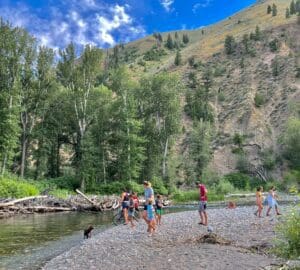Summer Safety Tips
 Be safe around the water
Be safe around the water
Every day, an average of 11 people die in the U.S. from unintentional drowning — and one in five of those are children 14 or younger according to the Centers for Disease Control and Prevention (CDC). The Red Cross wants everyone to know critical safety knowledge and skills that could save your life in and around the water. We encourage families to build confidence in the water by learning to be safe, making good choices, learning to swim and how to handle emergencies.
- Preventing unsupervised access to water, providing constant, active adult supervision and knowing how to swim are critical layers of protection to help prevent drowning.
- Classes to learn how to swim are available for both children and adults. Check the map for Learn-to-Swim providers in your community. Everyone should learn first aid and CPR too, so they know what to do in an emergency.
- Download the Red Cross Swim app, sponsored by The ZAC Foundation, for safety tips, kid-friendly videos and activities, and take the free Water Safety for Parents and Caregivers online course in English or in Spanish.
- It’s best to swim in a lifeguarded area. Always designate a “water watcher” whose sole responsibility is to keep a close eye and constant attention on everyone in and around the water until the next water watcher takes over.
- Drowning behavior is typically fast and silent. Unless rescued, a drowning person will last only 20 to 60 seconds before submerging. Reach or throw, don't go! In the event of an emergency, reach or throw an object to the person in trouble. Don't go in or you could become a victim yourself. Test your knowledge!
- It only takes a moment. A child or weak swimmer can drown in the time it takes to reply to a text, check a fishing line or apply sunscreen. For additional information about staying safe while swimming in larger bodies of water like oceans or lakes, review our beach safety tips below.
- Avoid swift fast moving water at all times.
Camping safety
If a camping trip is in your plans, know the level of ability of the people in your group and the environment around you. Plan accordingly.
- Pack a first aid kit to handle insect stings, sprains, cuts and bruises and other injuries that could happen to someone in your group. Take a Red Cross First Aid and CPR course and download the First Aid app so that you will know what to do in case help is delayed. You’ll learn how to treat severe wounds, broken bones, bites and stings and more.
- Sprains and falls are some of the most common misfortunes travelers may face. Falls are the biggest threat, many due to poor decision-making, lack of skill or not being properly prepared. Dehydration is also a danger. Plan ahead for these dangers.
- Share your travel plans and locations with a family member, neighbor or friend.
- Bring nutritious food items and water, light-weight clothing to layer and supplies for any pets.
Grilling Safety
Though more than three-quarters of U.S. adults have used a grill — yet, grilling sparks more than 10,000 home fires on average each year. To avoid this, the Red Cross offers these grilling safety tips:
- Always supervise a barbecue grill when in use. Don’t add charcoal starter fluid when coals have already been ignited.
- Never grill indoors — not in the house, camper, tent or any enclosed area.
- Make sure everyone, including pets, stays away from the grill.
- Keep the grill out in the open, away from the house, deck, tree branches or anything that could catch fire.
- Use the long-handled tools especially made for cooking on the grill to help keep the chef safe.
- Don't leave perishable food out in the sun.
Fireworks
The safest way to enjoy fireworks is to attend a public firework show put on by professionals, at least 500 feet away from the show. Many states outlaw most fireworks and it's best to leave any area where untrained amateurs are using fireworks. Keep in mind, all fireworks that leave the ground or explode are illegal in Idaho.
If you are setting fireworks off at home, follow these safety steps to help keep your community safe:
- Choose a location away from buildings and trees.
- Never give fireworks to small children, and never throw or point a firework toward people, animals, vehicles, structures or flammable materials. Always follow the instructions on the packaging.
- Be sure your spectators, including children and pets, stay well back.
- Keep a supply of water or a fire extinguisher at hand. If you live in an area that’s experiencing a drought, consider canceling the show this year – a stray spark that lands on dry grass or leaves can lead to a wildfire.
- Make sure the person lighting fireworks always wears eye protection.
- Light only one firework at a time and never attempt to relight "a dud."
- Store fireworks in a cool, dry place away from children and pets.
